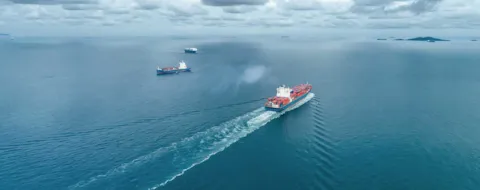EXISTING TONNAGE
As carbon trajectories tighten, what are the best options for existing tonnage to meet the regulations while maintaining economic viability.
A vessel’s age, drydocking schedule, and the overall cost benefit analysis will all impact the decision to investment in keeping a ship in operation – especially under tightening GHG regulations.
In some cases, opting for a newbuilding may be the right decision, based on the cost and complexity of a retrofit or conversion. However, if the numbers add up, there are a number of options to lower an existing ship’s carbon intensity.
Retrofitting vessels to accommodate new fuels is a possibility, but there are also many energy efficiencies measures, both technologies and operational changes that could keep a vessel in the water with good ROI or even negative abatement costs.
Ship design
Changes to the hull design, to improve hydrodynamics and reduce drag, could be explored (e.g. bulbous bow retrofit, vessel widening, rudder and propellor redesign)
Hull coatings/Air lubrication
Using compressed air evenly distributed along a ship’s hull, owners can reduce the friction between the ship’s hull and seawater creating energy-saving effects. Also, advanced hull coatings and new technologies, such as remotely operated robotic hull cleaning systems, can significantly improve hull performance.
Wake-equalizing ducts
A wake equalizing duct is a ship hull appendage mounted in the inflow region of a screw propeller, increasing efficiency, thus reducing fuel consumption and GHG emissions.
Waste heat recovery systems
Systems developed specifically for marine use have been developed to take waste heat from the engines to heat the vessel and/or generate clean electricity, thus reducing emissions.
Electrification
While batteries do not yet generate enough power for deep sea shipping, they can be used for onboard supplementary or auxiliary power, thus reducing emissions. Electricity can also be generated from installed solar panels to power some onboard systems.
Wind assisted propulsion
Advances in aerodynamics in combination with computer technology has produced a number of exciting wind-assisted technologies that can cut fuel consumption by up to 30%.
Owners of existing tonnage also can make operational changes that can have a significant impact on carbon emissions.
Slow steaming
A vessel’s fuel consumption for propulsion is a function of the energy needed to push a vessel through water at a given speed. The faster a vessel travels, the more fuel is required. However, by maintaining a constant, slower speed, vessels can both reduce fuels costs and corresponding emissions. While effective, it should be noted that reducing speed may have commercial implications that will impact charter agreements.
Voyage optimisation
Because more fuel is required to navigate strong currents, heavy wave forces and high winds, voyage planning can impact fuel consumption. By leveraging real-time information on sea conditions and weather data, owners can choose the best possible routes to avoid suboptimal conditions, thus reducing emissions.
Trim optimization
Trim optimisation (or how the disposition of cargo impacts hull hydrodynamics), can reduce emissions and fuel consumption by up to six per cent. While the impact may vary, trim and draft optimisation is applicable to all vessel types.

